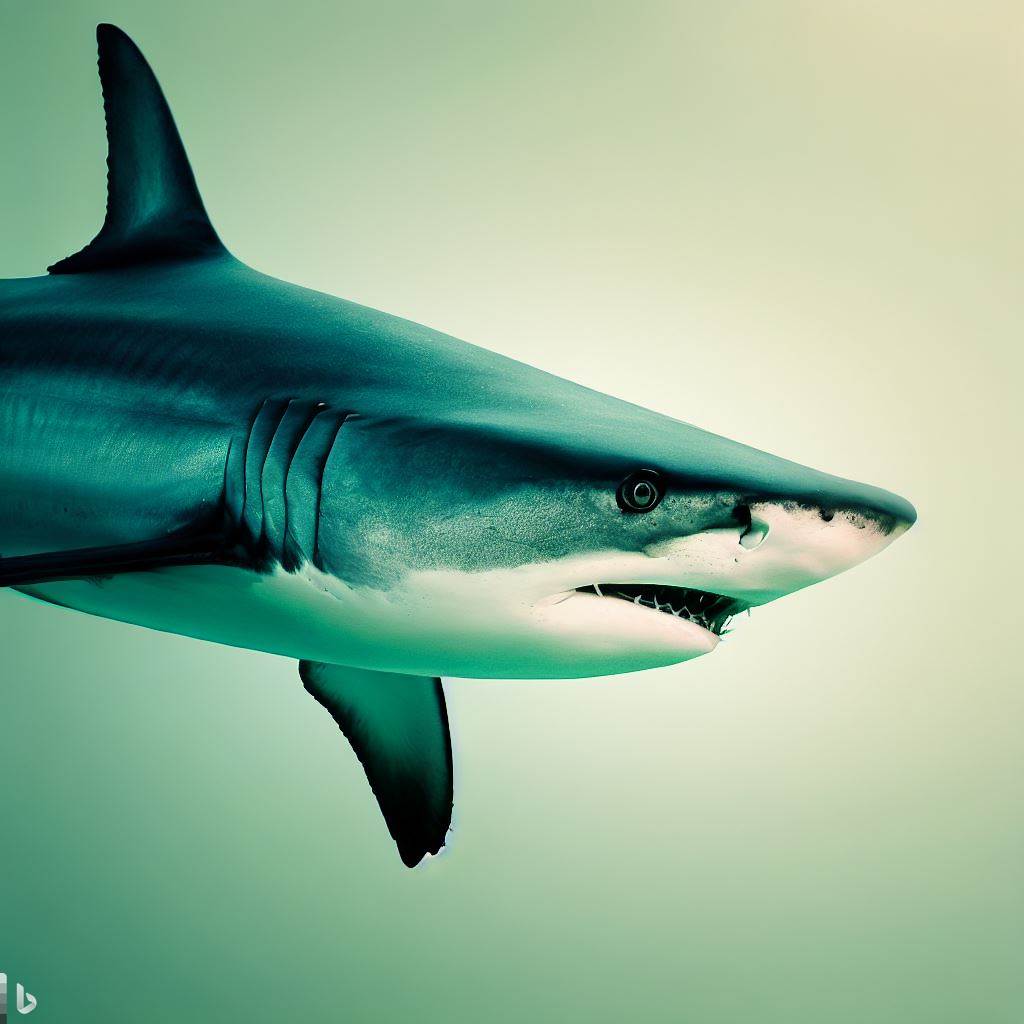Shortfin mako shark

The shortfin mako shark, scientifically known as Isurus oxyrinchus, belongs to the mackerel shark family. This species can grow to an impressive size, reaching lengths of up to 4 meters (13 ft) and weighing around 570 kilograms (1,260 lb). Its slender, cylindrical body is perfectly adapted for swift and agile movement through the water.
With its brilliant metallic blue coloration on the dorsal side and contrasting white on the ventral side, the shortfin mako shark displays a striking appearance. The transition between these two colors is well-defined, enhancing its overall beauty. Larger individuals tend to have darker coloration, extending onto areas that would typically be white in smaller specimens. The snout and mouth area are predominantly white, providing an additional contrast.
It's worth noting that the shortfin mako shark bears a resemblance to its close relative, the longfin mako shark (Isurus paucus). However, the longfin mako shark can be distinguished by its larger pectoral fins, darker coloration around the mouth, and larger eyes. Furthermore, the mako shark can be differentiated from the porbeagle sharks by the presence of only one lateral keel on its tail and the absence of lateral cusps on its teeth.
Behavior: Speed and Acrobatics
The shortfin mako shark is renowned for its remarkable speed and agility, making it a sought-after species for game fishing enthusiasts worldwide. This shark is capable of leaping out of the water when hooked, displaying astonishing aerial acrobatics. There have even been documented cases of shortfin mako sharks jumping directly into boats after being hooked, leaving observers in awe of their power and athleticism.
Reproduction: Life's Wonders
The shortfin mako shark follows a fascinating reproductive strategy. It is a yolk-sac ovoviviparous species, meaning the embryos develop within the uterus and receive nourishment from unfertilized eggs. This process, known as oophagy, sustains the developing embryos throughout a gestation period lasting approximately 15 to 18 months.
Unlike the sand tiger shark, the shortfin mako shark does not engage in sibling cannibalism. After the gestation period, four to eighteen live young, measuring about 70 centimeters (28 in) in length, are born in the late winter and early spring. Following the birth, female shortfin mako sharks may take an 18-month rest before engaging in mating activities once again. On average, these sharks reproduce every three years.
A noteworthy mating strategy observed in shortfin mako sharks is polyandry, where females mate with multiple males. This strategy ensures a single brood with multiple paternity. Polyandry is a common mating strategy observed in various taxa, ranging from invertebrates to vertebrates.
Lifespan: Unlocking the Secrets
Determining the age and lifespan of shortfin mako sharks has been a subject of scientific interest. In the past, estimations of sexual maturity and longevity were largely underestimated due to misconceptions about their growth patterns. However, a landmark study in 2006 provided validated ages for numerous specimens, shedding light on these crucial parameters.
According to the study, the maximum age recorded for male shortfin mako sharks is 29 years, with a corresponding length of 260 centimeters (8.5 ft) from fork to tail. Females, on the other hand, can live up to 32 years, reaching lengths of 335 centimeters (10.99 ft). Sexual maturity is achieved at around 8 years for males (185 centimeters or 6.07 ft) and 18 years for females (275 centimeters or 9.02 ft).
The corrected age findings have significant implications for fishery management models and ecological risk assessment models worldwide. By accurately accounting for longevity and age at sexual maturity, conservation efforts can be better informed and more effectively implemented.
Intelligence: Unveiling the Mind
Among the diverse array of shark species, the shortfin mako stands out with one of the largest brain-to-body ratios. This notable attribute prompted researchers to explore the intelligence of these magnificent creatures. The results of their studies revealed remarkable insights into the cognitive abilities of the shortfin mako shark.
Through tests involving shape differentiation, electroreception, and individual recognition, researchers observed that shortfin mako sharks exhibited fast learning capabilities. These sharks demonstrated the ability to discern whether researchers posed a threat and displayed unique behaviors during the experiments. Notably, they refused to roll back their eyes during feeding and allowed brief restraint and touch while being offered bait.
Unlike their great white shark counterparts, shortfin mako sharks rely less on electroreception when hunting. Instead, they primarily rely on their acute sense of smell, hearing, and exceptional vision. These findings challenge previously held assumptions about the sensory strategies employed by different shark species.
To summarize, the shortfin mako shark is an extraordinary predator that possesses both physical prowess and cognitive adaptability. Its swift movements, striking appearance, and remarkable intelligence make it a captivating species to study and admire.


